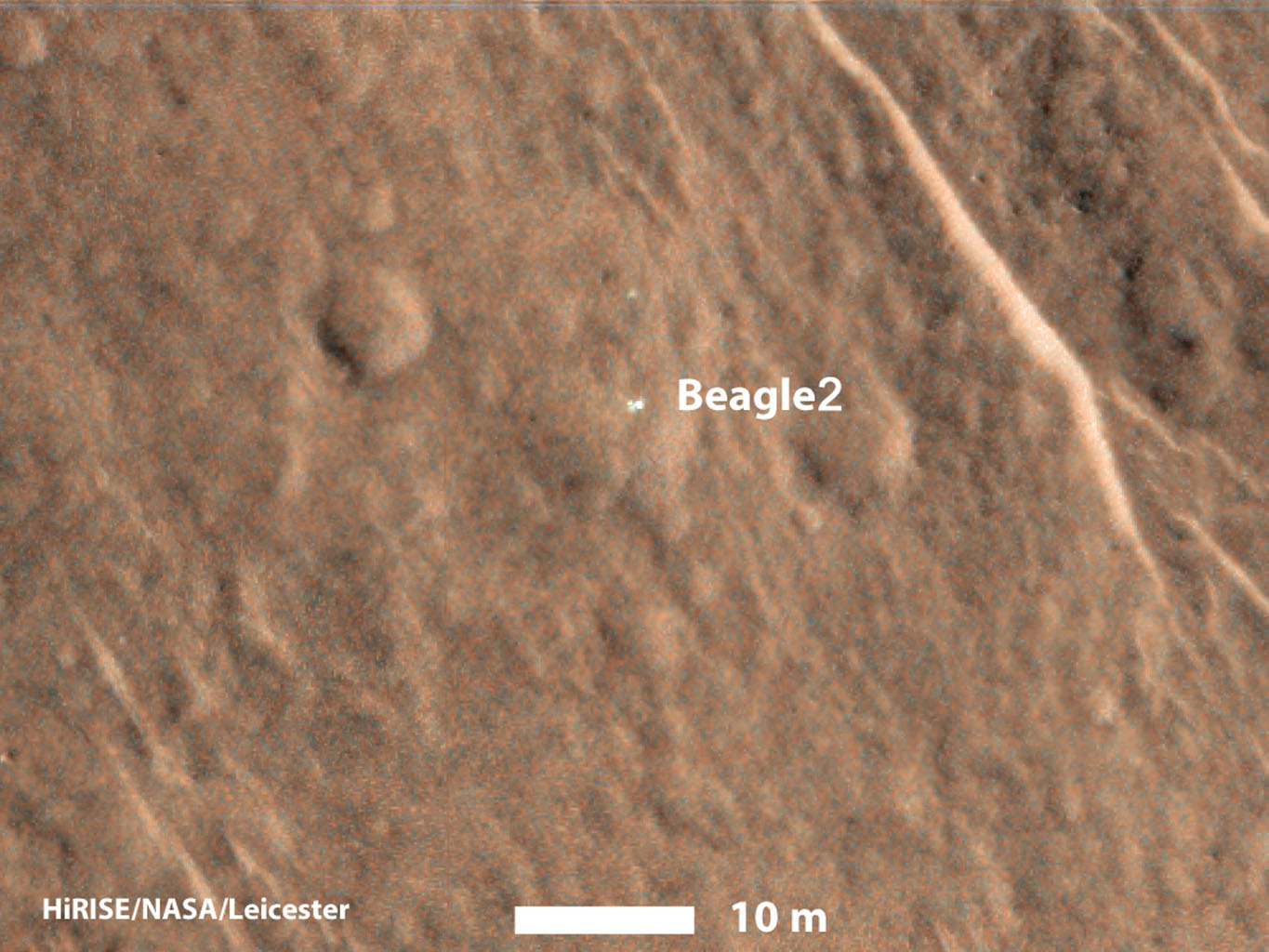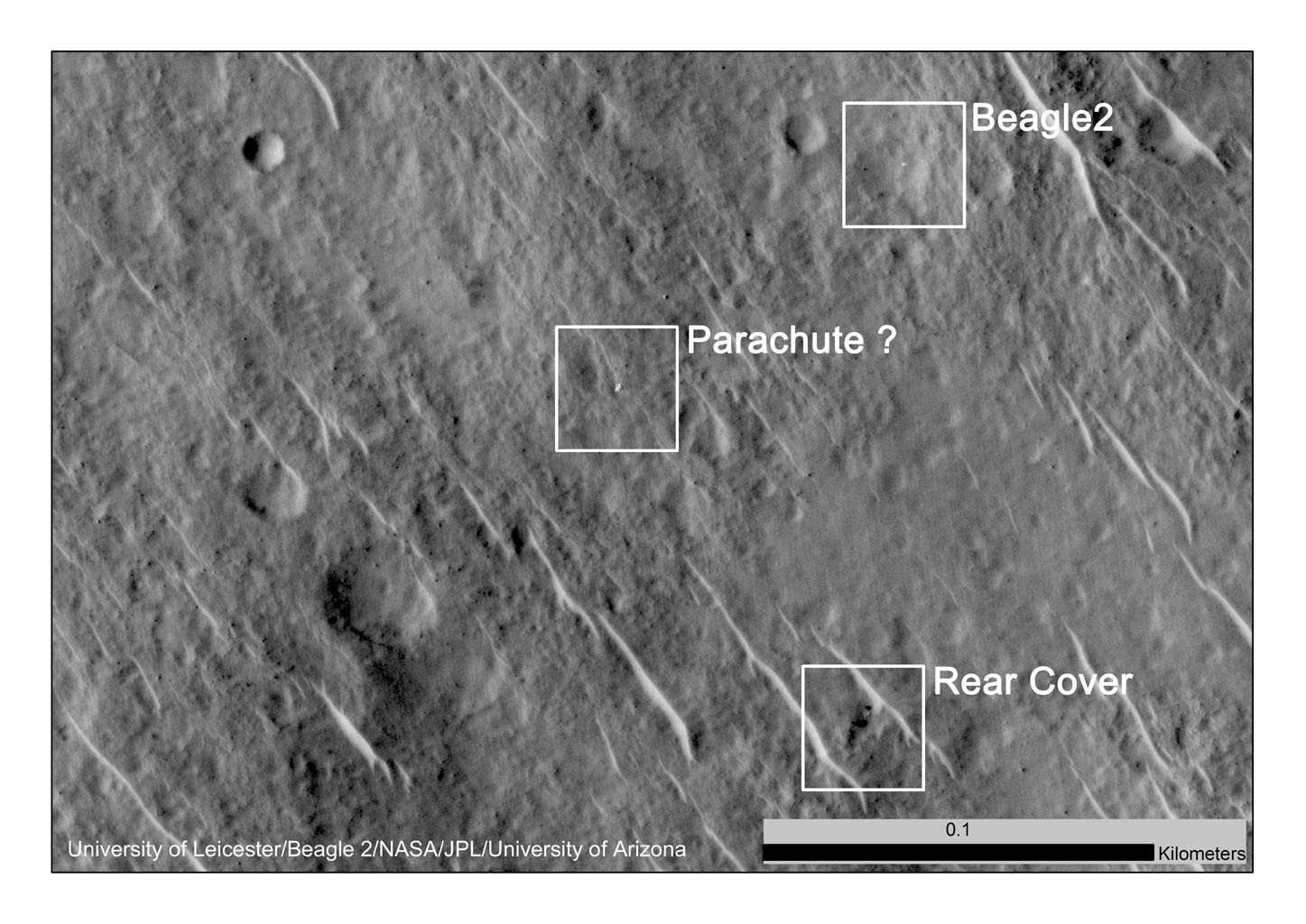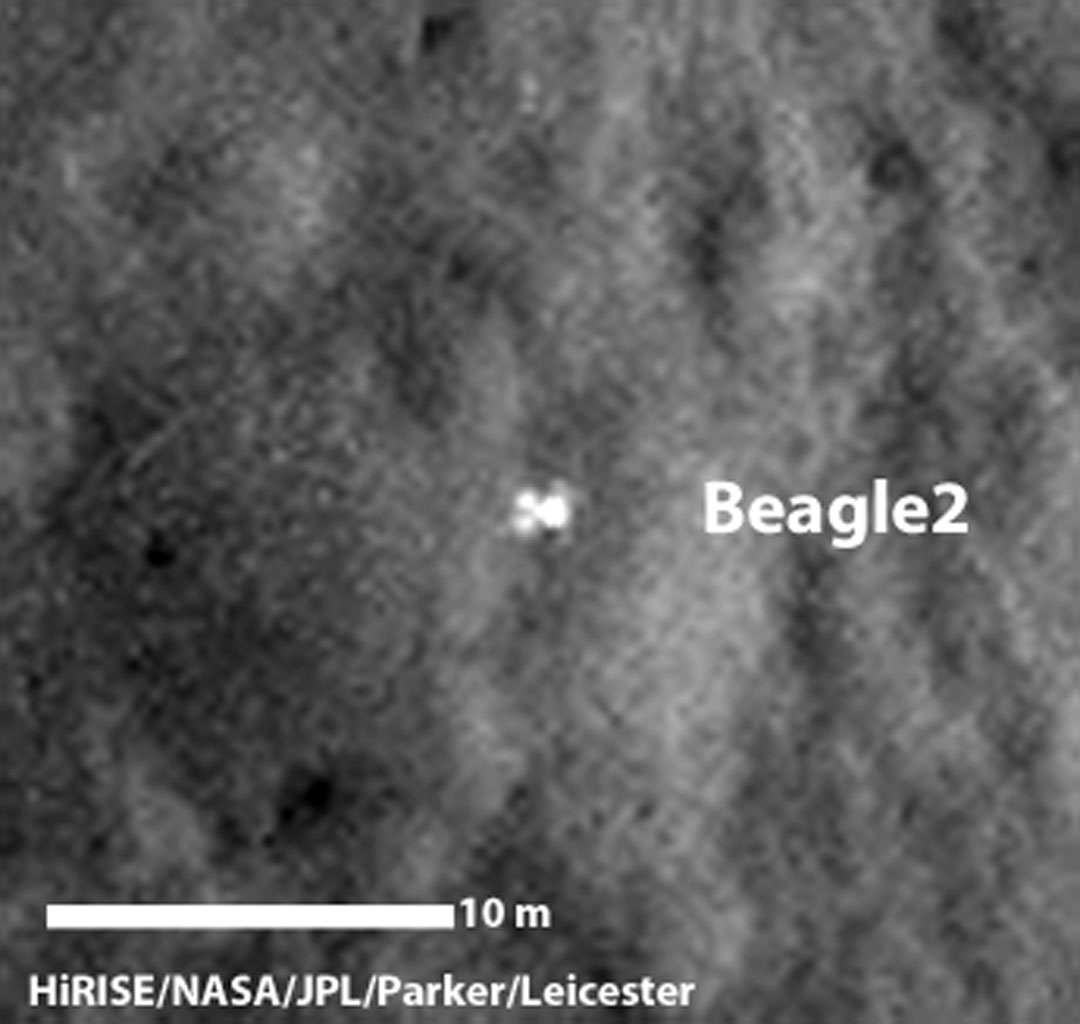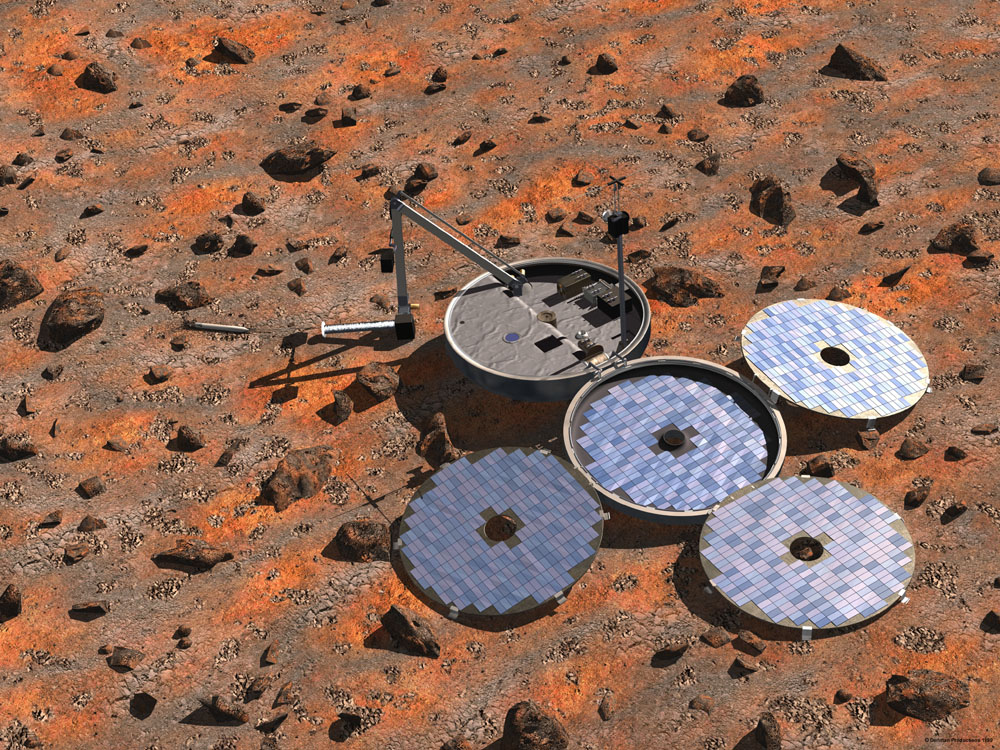The United Kingdom's Beagle 2 Mars lander, which mysteriously disappeared during a landing attempt over Christmas in 2003, has finally been found by a NASA spacecraft orbiting the Red Planet.

The Beagle 2 Mars lander is clearly visible in new photos from NASA's sharp-eyed Mars Reconnaissance Orbiter (MRO) in orbit around the Red Planet. The discovery shows that the probe landed successfully, but failed to unfold itself properly on the Martian surface, UK Space Agency officials announced today (Jan. 16).
The spacecraft, which hitched a ride to Mars on the European Space Agency's Mars Express mission, had not been heard from since it detached from that spacecraft on Dec. 19, 2003. Beagle 2 was supposed to land on Mars six days later, on Dec. 25. But when the lander never phoned home, many experts assumed Beagle 2 had crashed on Mars. Now, the mission's science team knows that's not the case. [The Search for Beagle 2 in Photos]
"The history of space exploration is marked by both success and failure," UK Space Agency Chief David Parker said in a statement. "This finding makes the case that Beagle 2 was more of a success than we previously knew and undoubtedly an important step in Europe's continuing exploration of Mars."

The search for Beagle 2
The search for the Beagle 2 Mars lander in NASA's MRO images was initially performed by former ESA Mars Express operations team member Michael Croon, who worked with the Beagle 2 lander's science and industrial team to painstakingly review NASA images in the hope of finding the missing lander. Because of the small size of the clamshell-like Beagle 2 (the lander measured 7 feet across, or 2 meters, when unfolded), it was right at the limit of MRO's imaging capabilities, NASA officials said.
Images from MRO's HiRISE (High Resolution Science Experiment) camera show that Beagle 2 indeed survived the harrowing entry, descent and landing sequence to touch down inside its target landing area in the Isidis Planitia region of Mars. It was about 3 miles (5 kilometers) from the center of its target landing zone, according to an ESA description. [The Best (and Worst) Mars Landings Ever]
"To be frank, I had all but given up hope of ever knowing what happened to Beagle 2," said former Beagle 2 mission manager Mark Sims, of the University of Leicester, in the UK Space Agency statement. "The images show that we came so close to achieving the goal of science on Mars. The images vindicate the hard work put in by many people and companies both here in the UK and around Europe and the world in building Beagle 2."
Get the Space.com Newsletter
Breaking space news, the latest updates on rocket launches, skywatching events and more!

Beagle 2 appeared to have only a few of its four solar arrays deployed, perhaps three at most. The lander's main parachute was seen close by, and the lander's rear cover and drogue parachute appeared to be still attached to the lander's main body.
The lander used parachutes to slow its descent, and then deployed airbags to bounce to a stop much like NASA's successful Mars rovers Spirit and Opportunity. But Beagle 2's design required a full deployment of its four solar arrays to expose its radio antenna, the vital link to Earth. Because the antenna was not free, Beagle 2 was unable to phone home to relay data and await instruction. It was stuck, forever silent, on the surface of Mars.
"Not knowing what happened to Beagle 2 remained a nagging worry," said Rudolf Schmidt, ESA's Mars Express project manager in 2003. "Understanding now that Beagle 2 made it all the way down to the surface is excellent news."
NASA scientists said they were happy the MRO spacecraft was able to help solve the mystery of Beagle 2. After all, NASA has had its own experiences with lost Mars landers. The U.S. space agency's Mars Polar Lander went missing on Dec. 3, 1999 during its own ill-fated landing attempt. [Occupy Mars: Robotic Missions to the Red Planet (Infographic)]
"I can imagine the sense of closure that the Beagle 2 team must feel," MRO project scientist Richard Zurek, of NASA's Jet Propulsion Laboratory in Pasadena, California, said in a NASA statement. Zurek also was project scientist for the lost Mars Polar Lander. "MRO has helped find safe landing sites on Mars for the Curiosity and Phoenix missions and has searched for missing craft to learn what may have gone wrong. It's an extremely difficult task, as the craft are small and the search areas are vast. It takes the best camera we have in Mars orbit and work by dedicated individuals to be successful at this."
The UK's Mars lander

The UK-led Beagle 2 — which was named after HMS Beagle, the ship that carried a young Charles Darwin around the world in the 1830s — looked like a giant pocket watch, with a protective outer casing that would open upon touchdown. At that point, the lander's four solar panels would unfold, its robotic arm would spring into action and Beagle 2 would get to work on the Martian surface.
The mission was led by British scientist Colin Pillinger, a researcher with Open University who kept searching for Beagle 2 with his team after the lander fell silent. Sadly, Pillinger died in May 2014 without learning the ultimate fate of Beagle 2.
"It was a great project. Colin enthused everybody," Sims said in a video recollection released by the University of Leicester today. "I just find it sad that Colin passed away last May and unfortunately will never know how close Beagle 2 got to doing the world-class science that he and the rest of the team proposed."
Beagle 2's work on Mars would have been varied and ambitious.
The lander was designed to hunt for signs of possible life on Mars and characterize Martian geology, weather and climate, among other tasks. Its science gear included two stereo cameras, a microscope, two different spectrometers, a sample-heating gas analysis package and weather sensors, along with a drill and a burrowing, sample-collecting instrument dubbed the "mole."
Beagle 2 cost about $120 million, one-third of which was provided by the UK government. The total cost of the Mars Express mission, which blasted off in June 2003, was about 300 million euros ($350 million at current exchange rates), ESA officials have said.
The Mars Express orbiter is still going strong today, more than 11 years after arriving at the Red Planet.
Late 2003/early 2004 was a busy time for Mars landings. NASA's twin Spirit and Opportunity rovers touched down a few weeks apart in January 2004, on three-month missions to search for signs of past water activity on the Red Planet. Spirit stopped communicating with Earth in March 2010, while Opportunity is still rolling along today.
"Beagle 2 wasn't a failure by any stretch of the imagination," Sims said. "We trained a whole generation of engineers and scientists in Mars exploration."
Space.com managing editor Tariq Malik (@tariqjmalik) contributed to this report. Follow Mike Wall on Twitter @michaeldwall and Google+. Follow us @Spacedotcom, Facebook or Google+. Originally published on Space.com.
Join our Space Forums to keep talking space on the latest missions, night sky and more! And if you have a news tip, correction or comment, let us know at: community@space.com.

Michael Wall is a Senior Space Writer with Space.com and joined the team in 2010. He primarily covers exoplanets, spaceflight and military space, but has been known to dabble in the space art beat. His book about the search for alien life, "Out There," was published on Nov. 13, 2018. Before becoming a science writer, Michael worked as a herpetologist and wildlife biologist. He has a Ph.D. in evolutionary biology from the University of Sydney, Australia, a bachelor's degree from the University of Arizona, and a graduate certificate in science writing from the University of California, Santa Cruz. To find out what his latest project is, you can follow Michael on Twitter.









